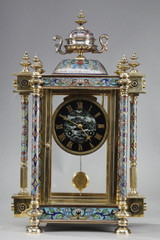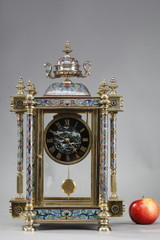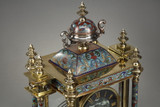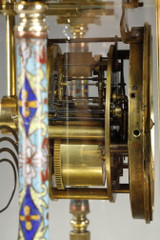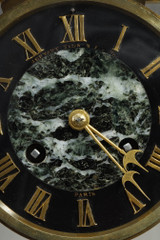Oriental-style Art Nouveau bronze and polychrome cloisonné enamel cage clock. The bronze structure is gilded and copper-plated, and decorated in places with acanthus leaves and flowers. The entire mechanism is encircled by six richly floral columns, four of which form feet. Each shaft ends in a button in a very oriental style. The round dial has an Alpine green marble center and displays the hours in Roman numerals. It bears a signature on the front, "SERVANT FILS & J, Paris".
This 1900 clock testifies to the appeal of the Orient and Orientalist aesthetics, which flourished in Western countries throughout the 19th century.
Circa: 1900
Base dimensions: 27 cm x 19 cm (10.63 in x 7.48 in)
Overall dimensions: W: 27cm, D: 19cm, H: 44cm.
Overall dimensions: W: 10.6in, D: 7.5in, H: 17.3in.
Condition report: In good condition. light wear to gilding. Chips on the inside of the glass door. The movement has been cleaned, serviced and is in working order.
The cloisonné enamel technique
Cloisonné is a technique for making objects with enamel decoration encircled by curved copper wires. This ancestral process originated on the Arabian Peninsula and was imported to China in the 13th century. Craftsmen quickly adopted the technique and developed it into a typically Chinese art form, which reached its golden age during the Ming dynasty. Chinese cloisonné can be found on numerous objects such as vases, bowls and chests, and fascinates with its impressive number of partitions, giving it a rich and unique decoration. From the 14th century onwards, Peking enamels spread beyond China's borders, and were collected in Asia and Europe.
In the 19th century, Ferdinand Barbedienne, a great collector of Far Eastern cloisonné, introduced enamel to his art objects. He worked in particular with the artist Fernand Thesmar, and French cloisonné enamel production was launched in 1872.
- Reference :
- 3154
- Width :
- 27 (cm)
- Height :
- 44 (cm)
- Depth :
- 19 (cm)
- Period::
- 19century
- Style ::
- Chinese
- Materials::
- Bronze, cloisonné enamel

